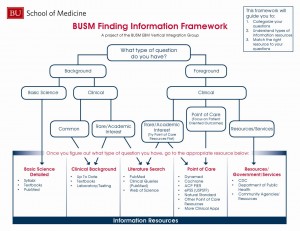Introducing: BUSM’s Finding Information Framework (FIF) – Conceptual Algorithm, Practical Web-based Tool
In this age of rapid information expansion, medical education no longer can be structured solely around information acquisition. Faculty need to teach the concepts and lifelong learning skills of information management and information mastery to be used both at the “point-of-learning” and later applied in the clinical setting at the point-of-care. Recognizing that these concepts can be difficult to teach, the Boston University School of Medicine (BUSM) Evidence-based Medicine (EBM) Vertical Integration Group developed the “BUSM Finding Information Framework” – a conceptual algorithm as well as a practical web-based tool – to structure how medical students ask and categorize their questions and link them directly to the most appropriate information resource to answer their question. This framework is the basis of its longitudinal EBM/Information Mastery curriculum, which is woven throughout the four years of medical school.
“This new approach emphasizes the principles of adult learning and highlights the continuously changing and growing nature of the body of medical information. BUSM is training our students to be lifelong learners who can perform accurate self-assessment of their own learning needs, and can use information resources both for their own education, and for application during patient care,” said BUSM’s Director of Medical Student Education, Department of Family Medicine Miriam Hoffman, MD.
 How it works
How it works
The student-centered tool, the “Finding Information Framework” (FIF), starts with students generating a question (based in the concepts of adult learning).
The FIF takes learners through an algorithm, much like a mathematical factor tree, to define their question first by determining whether it is a foreground or a background question. Once they continue down the algorithm, background is split into basic science or clinical. Clinical background is further split into common and rare/academic interest. Foreground questions are defined as always being clinical, and are split into point of care, rare/academic interest, and resources/services. Once students are able to put their questions into one of these final categories, they are directed to the appropriate information resource group to answer them. Each information resource group has a list of recommended resources. The framework is housed on the BUSM library website, so students can use it with direct one-click links into the actual resources (e.g. e-textbooks, databases, point-of-care resources, websites, etc.).
This framework and its concepts are taught to students early in the first year, reinforced throughout the curriculum and builds on itself over the four years. It is used in multiple courses including the medical library curriculum, the EBM/biostats course, the problem-based learning course, and the Family Medicine clerkship. Feedback from students has been overwhelmingly positive, with an emphasis on how logical and relevant this to their learning needs.
“Traditional EBM curricula focus mainly on concepts of study design, evidence based medicine theory, and the primary literature, and less on effective application of evidence in real time at the point-of-care. This curriculum teaches these difficult concepts and skills to students throughout the four years of medical school in a way that builds on itself and is relevant to students. It can also be a powerful faculty development tool. It is simple, clear, and intuitive to both students and faculty alike and can serve to frame these concepts for both,” said Hoffman.
Learn more about BUSM’s Curricular Innovations at http://www.bumc.bu.edu/oaa/curricular-innovations/ including the Finding Information Framework http://medlib.bu.edu/busm/fif/.
View all posts